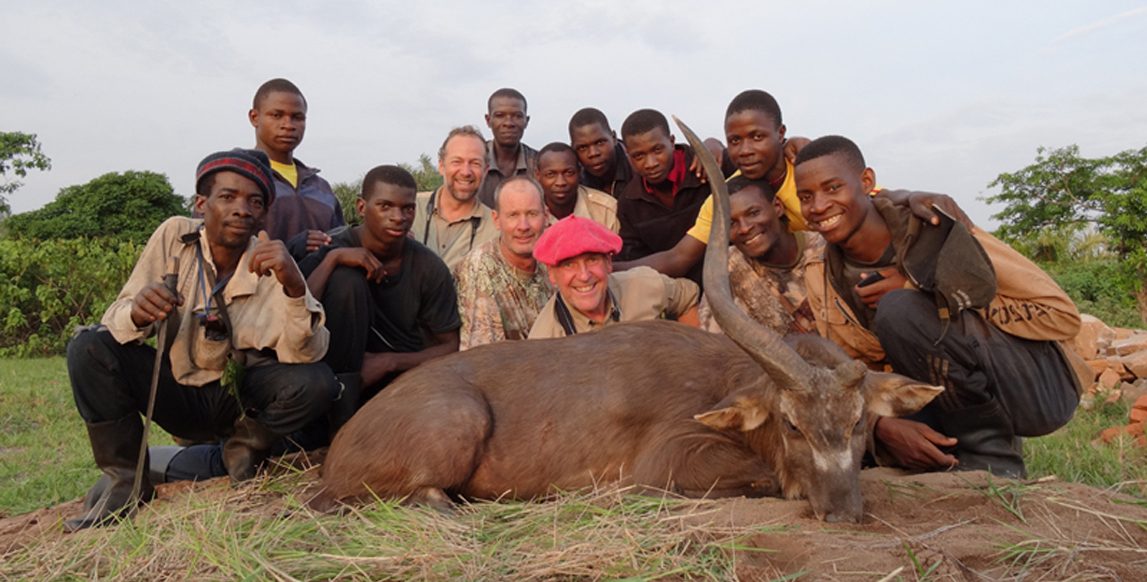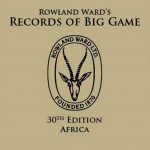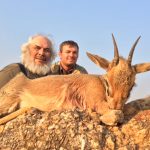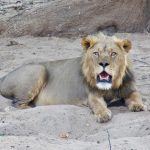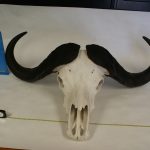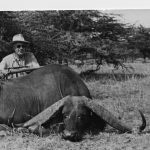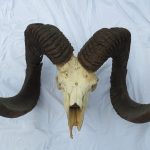Records of Big Game editors answer frequently asked questions about Rowland Ward’s recordkeeping system.
Photo above: This one-horned island sitatunga, taken in Uganda, is a great example of why antelope species are ranked on a single-horn measurement in the Rowland Ward system.
Q: Why are Rowland Ward minimum scores for all antelopes and ibex based on the length of a single horn? Now that all heads have both horns measured, why keep the single-horn standard?
A: Rowland Ward’s Records of Big Game has had a minimum measurement for inclusion in the book based on a single horn since its founding in 1892. First and foremost, ranking on one horn promotes sound conservation. Should a hunter be in the field and see a very old kudu or ibex with its left horn broken off to a stump and its right horn well into the 50-inch range, the animal will qualify for Rowland Ward’s record book despite the broken horn. Such an animal has survived predators and extreme weather and is, from a conservation point of view, an animal that can be sustainably hunted. If the minimum score was based on both horns, such a fine animal would not qualify and some hunters might pass it up. (An excellent example of this is a recent entry in Records of Big Game of a tremendous one-horned island sitatunga from Uganda.) Maintaining a record book is done for various reasons, but encouraging sound conservation and best hunting practices are its most important elements. To encourage this, RW will continue its single-horn policy while at the same time recording the lengths of both horns(when present) as well as the base measurements as supplemental information.
An additional benefit is that this system is also easy to understand. Walk anywhere in kudu country and point to a good male and ask your PH, “What do you think the horns will measure?” Invariably you will be answered with an estimate of a single measurement around the horn spiral, such as “52 to 54 inches.”
Q: Why does Rowland Ward use the old British measurement system of inches and pounds?
A: Rowland Ward started in the UK in the late 1800s, and at that time it was the world’s dominant nation. Many countries continued to use inches and pounds until well after World War II. Through an odd quirk of history, the company has been always been based in countries that used the British system (England, South Africa, and now the United States). While it is true that almost the entire world is now metric (including Britain), it is also true that a great many hunters are from the USA and they only know inches, pounds, and gallons, which is referred to as the “standard” system in the US.
In hunting circles, the use of inches and pounds remains widely in use. Its usage has been around forever and it is widely understood in North America, Africa, and great sections of Asia, even today when most of Africa and Asia has switched to the metric system. Just like car tire rim sizes worldwide are still in inches, many trophies are indicated in inches. Everywhere Cape buffalo are hunted, professional hunters and their clients talk of a “40-inch buffalo” indicating its spread. Even with 90 percent of the world on a metric system, elephants are judged in British pounds, with the Holy Grail being a hundred-pounder. Everybody knows a superlative Marco Polo ram has 60 inches of horn length, and any North American sheep with 40 inches of horn is exceptional, even though all sheep are ranked on a cumulative point system of horn lengths, bases, and circumferences in Rowland Ward.
For the next edition of Records of Big Game (2023) the editors are considering publishing metric measurements in addition to standard. All minimums online are listed both in inches/centimeters and pounds/kilos. It’s possible the US will switch to metric in the future, but the editors suspect hunters will still talk about a 40-inch buffalo and a 60-inch kudu long after that.
Q: Why are bases not part of the measurements on antelopes and wild goats?
A: Rowland Ward does require the measurements of both horns and the bases to be recorded in the book, and all these measurements are published. The same with tusks; if there are two, both must be weighed and recorded (as well as tusk length and circumference, which are supplemental data). But Rowland Ward does not rank antelope on the total measurements of the lengths and bases. While Rowland Ward has been recording base measurements since its beginning in the early 1890s, for many antelopes, bases are hard to measure accurately, especially spiral-horned specimens such as eland.
For some antelopes, such as reedbucks, they are impossible to measure because of a soft pulpy base, which is a combination of skin and unformed horn that grows right above the skull at the base of the horns. This shrivels away in a matter of days after the animal dies. Measuring the length of antelope horns is not that hard and can be repeated and verified by different persons with a high degree of accuracy. On the other hand, measuring bases accurately is exponentially harder, especially for spiral-horned antelopes which have “lobed” and very uneven horn endings. The same holds true for antelopes with heavily ribbed horns.

